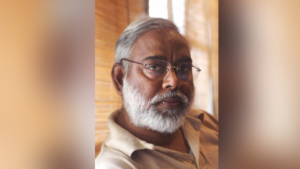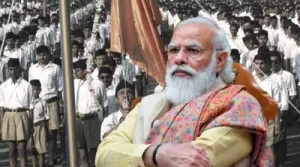The JCB machine has become a ubiquitous item in Varanasi since the past six years. Scraping away the very core of one of the world’s oldest cities, one project at a time — the Kashi Vishwanath Corridor, the redeveloped ghats, intermodal transport hub, the ropeway, Guru Ravidas Janmasthali temple and museum, UP’s largest cricket stadium and sports city, the six-lane expressway to Kolkata.
Since 2014, when Prime Minister Narendra Modi arrived here to contest the Lok Sabha elections and promised to turn Varanasi into Kyoto, the city has been in demolition and construction mode. But instead of sensitively leveraging the city’s rich heritage and cultural tapestry for his grand “temple tourism” idea, the government focus seems to be on creating a lasting monumental legacy of the Modi era by selectively using religion and caste in a bid to corner Hindu votes across the country and in the process benefit corporates and builders. Varanasi and its people are turning out to be the biggest losers in this bargain.
The gullies and temples that the city has been synonymous with, have been razed in hundreds to make way for the busy Vishwanath Corridor that has expanded the temple area from 3,000 sq ft to 500,000 sq ft. Many more are in line to get bulldozed to create connectivity and hospitality infrastructure under the new golden tourism triangle plan.
With thousands of acres of rich agricultural land up for grabs, the city green cover, including scores of centuries old trees, are just collateral damage in Kashi’s transformation from salvation city to a tourist hub.
But the government’s eyes are firmly set on linking and developing Prayagraj, Varanasi and Ayodhya to create a golden triangle of religious tourism in Uttar Pradesh. And the efforts are paying off too — in the 103rd episode of ‘Mann Ki Baat’, Prime Minister Narendra Modi mentioned that Varanasi is getting more than 10 crore tourists every year now.
According to the Ministry of Tourism data 8.5 crore people visited the city in 2023. And the numbers are reflected in the significant swell in donations to the Vishwanath temple — from Rs 58.51 crore in 2022-23 to Rs 83.34 crore in 2023-24. In March alone, the amount generated broke all previous records — touching Rs 11.14 crore — the highest for any month, according to the temple management.
That should please all those linked to the temple. The policemen and the priests are indeed a happy lot. The cops as they man the shrine dressed as priests, and priests who are now state employees. Ahead of the ongoing elections, the Uttar Pradesh government has regularised nearly 150 temple priests and caretakers bringing them at par with state employees in terms of salaries, leaves and other benefits.
But the private security staff still cribs of low wages amid increased work pressure with the rising footfall. One security guard said he got a meagre Rs 10,000 for a nine-hour shift. The vendors complain of increased competition and police high-handedness. Even those who have bought shops inside the temple premises are not happy. Ram Kripal lost his home and prasad shop to the Corridor.
“My brother and I got a paltry Rs 2 lakh each as compensation, while I paid Rs 16 lakh for a box-size kiosk inside the temple. At present the struggle is between make a living and getting my investment back. The story is the same for all those who’ve taken kiosks within the Corridor,” he said.
The booming temple economy has differently affected different people. Residents around it are the most bitter. “It’s a world lost forever — homes, livelihoods, temples, ornate wood and stone buildings, neighbours… three ancient and running libraries, thousands of books and dozens of Sanskrit gurukuls. Sab chala gaya. Vikas ki vedi pe virasat ki bali de di gai,” rued Bhola Singh, a flower vendor.
Naeem, who owns an ittar shop a few bylanes away, reminisced the time when Hindu shopkeepers around the temple would lay out Iftari spreads for Muslim devotees during Ramzan. “Till about five years back, coming out of the mosque after namaz was an experience everyone waited for,” a sentiment echoed by a Muslim weaver as well.
Today, as the Gyanvapi Mosque stands caged next door, one can only sense the growing chasm between the two communities. A priest inside the temple said he was happy the Muslims had been shown their place. Beyond Godoliya, the Corridor’s busy tourist marketplace full of souvenir, garment and snack shops, the narrow roads leading to the temple are clogged with cycle rickshaws, autorickshaws, e-rickshaws and other vehicles. A simple solution to the traffic congestion in these parts could be making them non-motorised transport zones, which would also benefit the cycle rickshaw-pullers who are right now losing the game to cheaper and faster e-rickshaws.
But the government would rather have the cycle rickshaws disappear than ruin the tourist experience. Just the way, it is trying to wish away thousands of mallahs (traditional boatmen) with the introduction of three cruise liners and mechanised boats on river Ganga. Their lives and livelihood disrupted, the mallahs have held several rounds of protests since 2018, but to no ears.
In Varanasi, Sarnath is to Buddhists, what the Vishwanath Temple is to Hindus. Among the three most important sites of the Buddhist pilgrimage circuit in India, this is where Gautam Buddha delivered his first sermon after Enlightenment.
Curiously, however, the government’s plans for Sarnath seem to be at odds with its exalted status. The government is planning a Vedic City in the ancient town, even as it sits on its bid for UNESCO World Heritage site status. A dossier of the ancient Buddhist sites in Sarnath has been languishing in UNESCO’s tentative list for over 25 years now. Reportedly, a revised dossier of these sites prepared by the Archaeological Survey of India (ASI) just last year, also awaits submission with the UNESCO World Heritage Committee.
Meanwhile, work on the Vedic City is on full swing. Some 109.9 hectares of land is being acquired in Paterwa, Hasanpur, Singhpur, Hridaypur and Bagatpur villages of Sarnath for the modern township, which will have luxury hotels, resorts, residential buildings, commercial complexes, shopping malls, a convention centre, a yoga centre and religious sites of different countries.
The Varanasi Development Authority (VDA) has also announced relaxation in restrictions on construction in Sarnath after consulting the ASI and other concerned departments. Could it be because visitors to Sarnath are largely foreigners and not a vote bank? Definitely not as the massive as the Ravidassia and Dalit communities from Punjab and abroad.
With eyes firmly on these visitors and also their votes, has the redevelopment of the Sant Guru Ravidas Janmasthali temple at Seer Govardhanpur been undertaken spending over Rs 100 crore. The temple, dedicated to Sant Ravidas, an anti-caste icon, is now very well connected to the national highway and Lanka area, and its gold plated chhatri can be seen from afar. There is also a massive Sant Ravidas statue, a park and a grand memorial museum worth about Rs 62 crore is coming up soon.
Since Punjab has the largest number of Ravidas’ followers, Begampura Express, a special train runs between Jalandhar and Varanasi catering specially to the shrine devotees. In stark contrast, a few kilometres away lies Kabir Chaura Math, the shrine of Sant Ravidas’ contemporary and arguably Varanasi’s greatest anti-caste icon, mystic poet Kabir. It has few visitors (mostly locals and foreigners — the rest of India doesn’t seem to care much for Kabir), and appears in need of maintenance.
Enlarged pictures of newspaper cuttings announcing — a hi-tech memorial hut displaying his memorabilia and a 21-storey Sant Kabir superspeciality hospital at Kabir Chaura — are pasted on the walls of the Math, but those remain just that. Clearly Kabir’s followers don’t wield the clout and lucre of the Ravidassia vote bank.
Kabir was a julaha (weaver) and a revolutionary poet of the working class. But dismal state of weavers in Varanasi is evidence that the tourist surge and the government’s tourism-aligned showpiece schemes such as One District One Product (ODOP), to promote unique local crafts and industries, haven’t really helped this industry. Perhaps nothing can when the efforts are an eyewash and the real game is to benefit the saree industry in Gujarat at the cost of Benarasi weavers.
Migration to Surat and Bangalore for work among Benarasi silk saree weavers right now is at its peak in the past many years. With this the Banarasi cloth and pattern have also migrated to Gujarat, and fakes from Surat have flooded the market as Banarasi silk. “The arrival of the powerloom was the first blow to the handloom industry, the power subsidy dealt the next, the rest of the job was done by demonetisation and introduction of GST,” said Shahnawaz Akhtar, a weaver from Saraiyya area.
Weavers complain that under the relaunched flat rate electricity scheme, they are forced to shell out five times the power price. And the bills have to be paid between 10-15 of every month after which there’s a penalty of Rs 750. The raw material cost has also gone up. The thread which cost Rs 200 two years ago now costs Rs 900. Under the GST, the kharkhanas are taxed, but those with homes atop them are taxed doubly assuming that the women folk are working on more looms.
“The government is forcing us out of Banaras. It’s almost as if it is working on a mission to finish this industry,” said Akhtar.
(The author is an independent journalist. Courtesy: Counterview, a newsblog that publishes news and views based on information obtained from alternative sources, which may or may not be available in public domain, allowing readers to make independent conclusions.)




